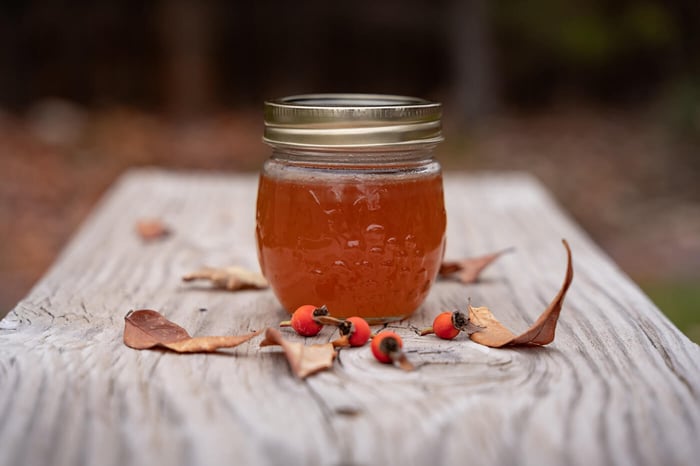Roses are a wonderful shrub for your landscape. They bring shape and structure to your garden, require very little water, and they bloom early and often. They’re a fairly simple addition to your yard throughout most of the year. Did you know that you can enjoy your roses even when they aren't in bloom? Roses are a key ingredient for a delicious jelly that you can't buy at the store. Rose hip jelly is something we have known about for years, but had never tried before, so we thought we’d bring you along with us as we ventured into this new culinary quest.
What’s a rose hip?
Often called the fruit of the rose, rose hips are the bulbous part of the rose flower just below the petals. Usually, rose hips are red or orange, but you will sometimes find yellow or even black hips. If you leave a few of them on your shrubs throughout the winter, you’ll provide food for birds during the cold months.
Technically, rose hips are edible, but you would have to be pretty hungry to eat them raw. They have a unique flavor, but they’re hard to eat because they’re full of seeds and hairy fibers that aren’t at all appetizing. That being said, they’re very high in vitamin C, and they make an interesting tart, honey-like, jelly that you’ll be proud to share with your friends.
The best rose hips are produced by shrub roses, ramblers, and other varieties that have easily accessible centers. Some types, like hybrid teas, have so many petals that bees and other pollinating insects cannot reach the center, so fewer hips mature into fruit. We learned that rose hips will be sweeter after the temperatures have dropped, so fall is an ideal time to try this recipe. Please note, however, that even the sweetest rose hip is not delicious if eaten raw. The most common way to consume rose hips is in the form of tea or jelly.
How To Make Jelly
The recipe we found called for 8 cups of rose hips. That’s a lot of rose hips. It can take some time to find that many. We had a handful of apricot drift roses in our yard and several more in a family member’s yard. We knew that none of these shrubs had been sprayed with pesticides, so we decided to harvest hips from these bushes.

It was a cold day when we harvested our hips, and our youngest daughter was feeling the chill, but she stayed with us for the whole excursion. After nearly an hour of harvesting, we ended up with just over 4 cups of hips, so we decided to half the recipe and see what we could make with them.

It takes time and patience to make rose hip jelly. After you harvest the hips, you need to snip the stems and the pedal parts off the hips, rinse them through a strainer and then boil them for at least an hour. We ended up boiling our rose hips for nearly 3 hours before they were soft enough to mash with a potato masher.



Once we had mashed them quite well, we lined our metal strainer with 4 layers of cheesecloth. We wanted to be sure that none of the undesirable parts of the hips ended up in our jelly.

We poured the pan of smashed hips and water into the strainer and allowed the resulting tea to drain for about 40 minutes. Some recipes said that we shouldn’t squeeze the cheese cloth to get the most out of it, while other recipes suggested that we should—so we did. Since this was our first attempt, we aren’t sure if doing so made things better or worse. The jelly seems fine.


In the end, we had three cups of rose hip ‘tea’ that we poured into a clean pan and boiled again. As the tea was heating, we added a package of pectin, a half cup of lemon juice, and 3 and a half cups of sugar. As the mixture began to boil, we added ¼ teaspoon of butter, then we allowed it to reach a rolling boil that was not at all affected by stirring. This rolling boil continued for a full minute, then we removed it from the heat and poured it into clean, warm jars.

This jelly will store well in your refrigerator for about 6 months. If you plan to store your jelly longer than that, you will want to seal your jars in a boiling water bath. Place new canning lids on your jars with the rings tightened finger tight. Place the jars on a rack in a large stock pot. Fill the pot with water until the lids of your jars are about an inch under water. Then bring the water to a rolling boil for ten minutes. Remove your jars from the heat and leave them on your counter until they seal. If any jars don’t seal, keep them in the refrigerator and eat them first. Store the rest in your pantry until you're ready for a unique treat. Rose hip jelly makes a fun gift for friends and family.

Ingredients:
8 cups rose hips (We used 4 cups, but more would have been even better.)
6 cups water
1/2 cup lemon juice (Fresh squeezed would be extra nice.)
1 (1.75-once) package of pectin
1/4 teaspoon butter
3 1/2 cups sugar
What We Learned:
Our pectin didn't set up. Our jelly turned out to be more like a thick syrup than a jelly. That's probably because we chose not to seal our jars in a boiling water bath. We had just a few jars of jelly and we felt like we would eat it fairly quickly. If our jelly had been in a boiling water bath for another ten minutes, that may have made a significant difference.
This jelly / syrup has been delicious on waffles, toast, and scones! We will certainly make it again.





